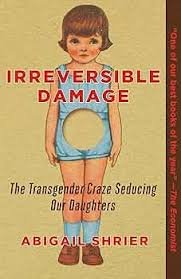Irreversible Damage: The Transgender Craze Seducing Our Daughters, by Abigail Shrier
Abigail Shrier, writing and researching as a journalist, presents facts that have been ignored in recent years, giving a practical, well-rounded discussion of the recent overwhelming increase in biological female children, tweens, and teens seeking transition to being boys. Shrier mainly focuses on this group (not greatly focusing on boys seeking to change to female), since trans sexual change (as it has formerly been called) was .01 percent of the population for a long time, and mostly males moving to female. Presently, the numbers rise each year, jumping from 20-50 percent, and becoming a mostly female to male phenomenon.
Shrier writes about other fixations that have gripped adolescent females in the past, such as eating disorders (pursuit of a “perfect” thin body using unhealthy, and often dangerous practices), cutting, teen pregnancy, drug use, and multiple personality disorder. When trying to determine causality, these are all complex issues, with singular, personal reasons and circumstances. Due to the rapid and pervasive spreading of the phenomenon, especially among female teens, it is easy to make a case for social contagion, noting how friend groups, discussing and sharing personal struggles apart from parents, engaged in rebellious behavior to separate from parents and discover personal identities, struggle for autonomy and agency, might latch on to a particular issue, especially if it satisfies all these adolescent needs and drives. Shrier writes about the smart phone and social media as means to speed up these identifications, receive affirmation for moving in that direction; these are issues previously discussed in Jonathan Haidt’s book, The Anxious Generation (https://www.margueritereads.com/home/the-anxious-generation-how-the-great-rewiring-of-childhood-is-causing-an-epidemic-of-mental-illness-by-jonathan-haidt). Excessive time spent viewing influencers’ videos, interacting online with supportive strangers, many of whom are often motivated to move teens deeper into a trans identity, as well as sharing only positives, not downsides of medical interventions.
While these ideas help explain the how, they do not really address the why, meaning why is female adolescent anxiety, depression, disconnectedness, and negative self-image of becoming a woman, so prevalent? Has it always been thus? Are female teens who do not fit the body type of female perfection giving up that part of their identity, rather than embarking on the journey of self discovery: what kind of woman will I become? Shrier points to online porn as part of the problem, setting up unrealistic images of femaleness. Our current culture medicalizes every area of our lives, with customers demanding a pill or procedure to address every issue. Add to these our cultural hyper-emphasis on feelings, which are often transitory, but can be viewed by tweens and teens as permanent and unbearable, and you can see the case Shrier presents for how this collective obsession took root.
If this were limited to hair color or tattoos, this would be a nonissue. Shrier presents the medical evidence for the harms done by hormone blocking medications take during puberty, testosterone taken by female teens and young adults, and the irreversible harms of top and bottom surgeries, rendering many young women sterile, unable to nurse a baby, and harming their natural sexual responses. Adults would normally call for slow, careful consideration, extensive discussion and deliberation before endorsing such life changing measures with teens—why is this so threatening to so many? I have only lightly touched upon the evidence and stories that Shrier shares. It is well worth exploring this book, and examining this widespread trend, that carries such grave consequences for those in its throes.

